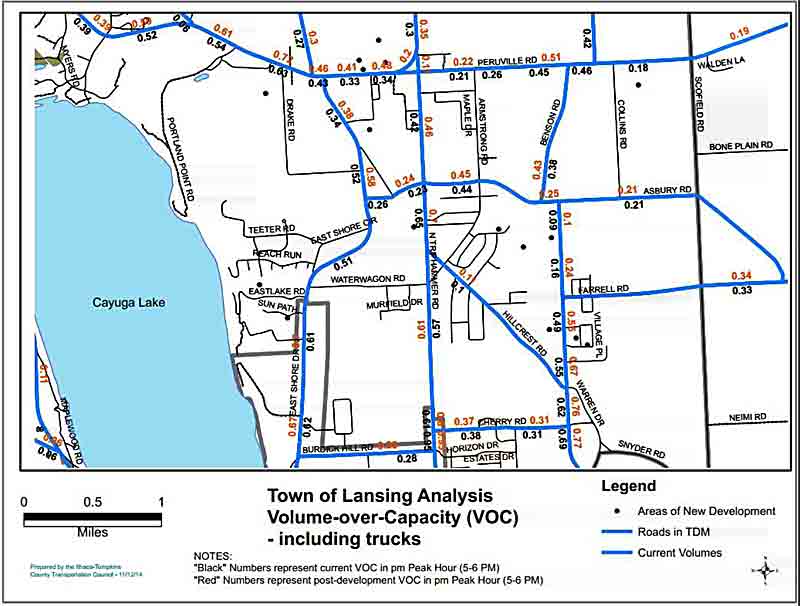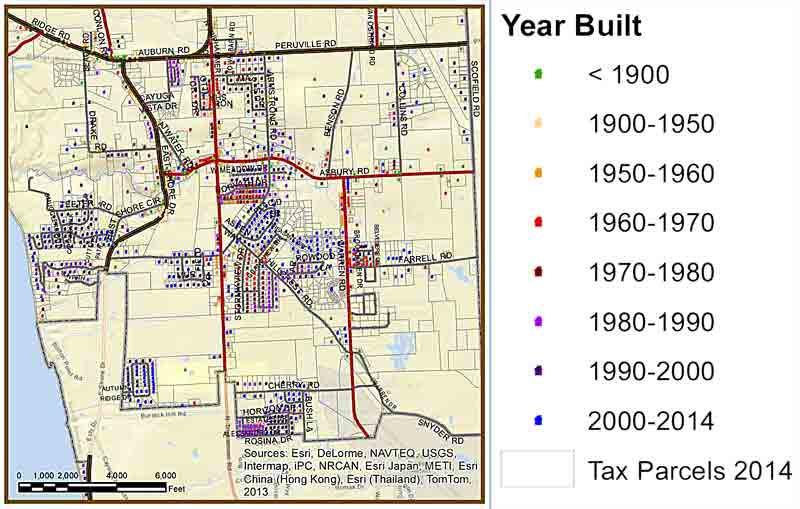- By Dan Veaner
- News
 Print
Print 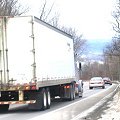 Lansing officials have been paying special attention to traffic maps as they assess the impact of significant new development in the township. With a dozen developments under review or approved that could increase the number of housing units by 495 and another handful that could raise that number by an additional 575 units, neighbors are understandably concerned about the traffic impact. But Lansing Planning Consultant Michael Long says that a recent study by Cornell University's Design Connect shows that Lansing's roads are currently well under capacity at the peak traffic hour between 5pm and 6pm.
Lansing officials have been paying special attention to traffic maps as they assess the impact of significant new development in the township. With a dozen developments under review or approved that could increase the number of housing units by 495 and another handful that could raise that number by an additional 575 units, neighbors are understandably concerned about the traffic impact. But Lansing Planning Consultant Michael Long says that a recent study by Cornell University's Design Connect shows that Lansing's roads are currently well under capacity at the peak traffic hour between 5pm and 6pm."A lot of people primarily drive through the community from Cayuga County to Cornell," Long says. "Cornell is the major magnet that drives a lot of traffic. A lot of people go via Triphammer. And as you go closer into the Village of Lansing the traffic really increases."
If you consider that over the past several years Lansing, which is now the fastest growing town in Tompkins County, has had an average of about 30 new units per year, and project those numbers out over a five to ten year period, the bump in housing units is significant. If every development on that list is built over the next decade we're talking about over 350% more development.
The maps provided in the study show a logical increase in traffic as you drive south toward the mall areas. North of Asbury Road Triphammer is currently running at 42%. South of Asbury Road that goes up to 65%, goes down a bit south of Waterwagon Road, then rises to 95% of capacity South of Cherry Road during the peak traffic hours. With three malls and a major arterial road, Route 13, crossing Triphammer at that point, it makes sense that the road capacity would be so high, even after the major Triphammer Road Reconstruction Project that was completed in 2006.
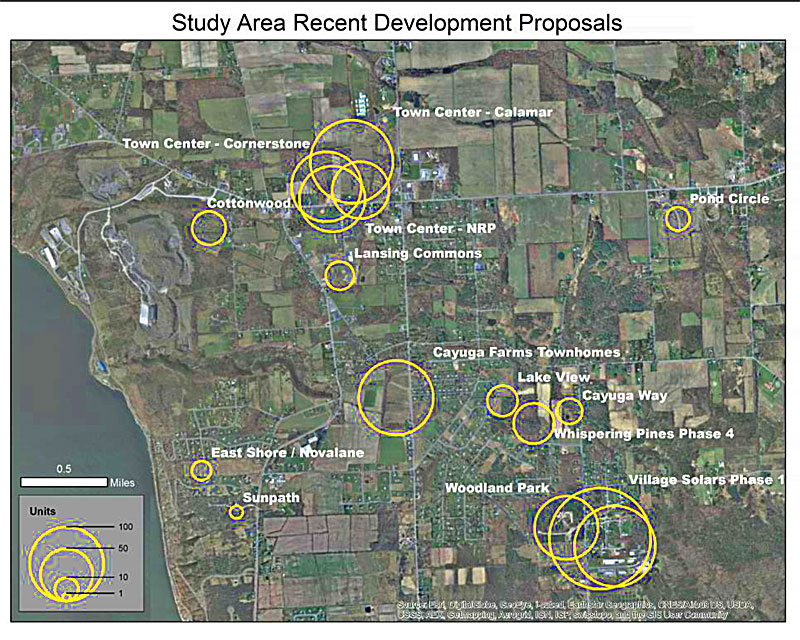 | 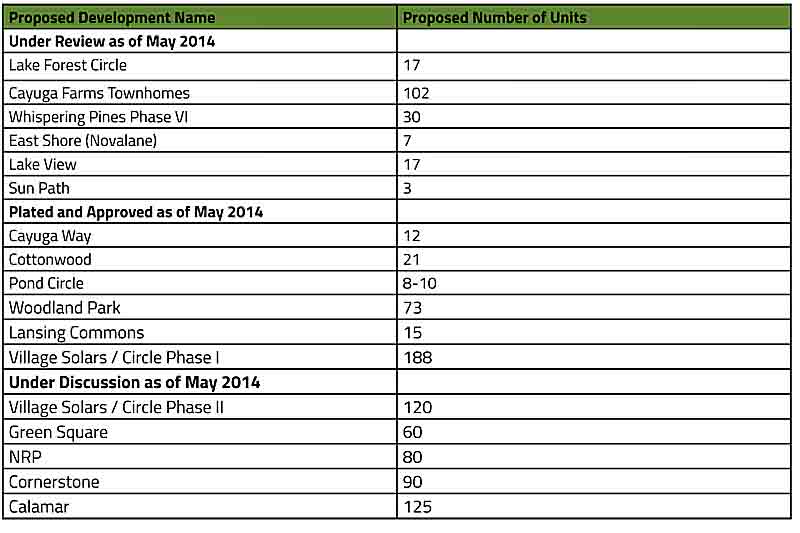 |
| The map on the left shows where proposed and current developments are located. The chart on the left shows how many new housing units each will generate. Click a graphic to enlarge it. | |
But in most of the Town the numbers hover on either side of 50%. While it is important for town officials to keep an eye on the impacts of new developments, increased traffic is less of a concern than it initially appears to be. That said, the state looks at the number of accidents at a particular intersection or section of a road before adding traffic lights or other speed mitigating devices. Or, as a number of local elected officials have said on numerous occasions, "How many people have to die before the state approves a stop sign or traffic light?"
Traffic lights and stop signs are not the only ways traffic is mitigated. Ithaca has installed raised crosswalks, essentially gentle speed bumps on many of their streets. But Lansing Highway Superintendent Jack French says that they are a nightmare to maintain, particularly here in the north where snow plowing is hampered and can damage the bumps. Other methods include adding turn lanes, controlling where and how many times streets in new developments make new intersections with existing roads, and the most extreme: widening the road.
Interestingly, Long says that many municipalities are reducing the number of traffic lights, in part to reduce their electric bills. But even though the lights facing in all directions will be mounted on a single arm suspended from one post on one corner of the intersection, Long says that special weight-sensing cables must be mounted into the asphalt in order to sense when cars are waiting, plus a computer to run the light, and equipment to facilitate pedestrian crossing signals on each corner, as well as those corner posts and signals themselves.
The Village of Lansing is spending about $200,000 this coming Spring to install a traffic light on the intersection of Triphammer and Craft Roads. While Mayor Donald Hartill says that pedestrian signals will not be installed, because Village officials do not want to encourage pedestrian traffic where there are no sidewalks, the capability to manage crosswalk signals is part of the package.
Long says that maintenance and replacement costs bring the bill even higher over the life of the signal. The current trend is to replace traffic signals with roundabouts, a much lower cost solution.
Two upcoming projects that have generated concern about traffic among their neighbors are the Novalane project and the Cayuga Farms Town Homes project. Novalane is quite small, but includes a road that will connect the East Shore Circle and East Lake neighborhoods. The first phase will only include seven homes, and the section of East Shore Drive that is impacted by the development is currently running at 52% in the peak hour. Long says the traffic impact will not be significant from only seven new homes. If all the developments are built out the study projects that same stretch of East Shore Drive will only rise to 58% of capacity.
"It's hard for the average person to understand how traffic works," Long says. "They feel it in terms of when they are driving down the street. In this general vicinity we're only talking about 51% of capacity."
Cayuga Farms is much bigger, with an eventual total of 102 new units. Again, the section of Triphammer Road that will be impacted is currently operating at 65%. The developer says a traffic study has shown that if the entire project is built out it will only impact traffic by 50 additional cars in the peak hour. If all the developments on the list are completed that section of triphammer Road will be operating at 70%, only 5% more than currently.
Design Connect students went to the Ithaca-Tompkins County Transportation Council and asked them for information," Long says. "They presented all the various developments that were either proposed or under consideration. They tried to figure out the existing capacities of the roads, as well as the increases would be if all these developments came to fruition. It really looks at a worst case scenario."
"Computer modeling for traffic is unique," Long says. "A certain percentage of traffic will go this way, a certain percentage will go east, some west... it divvies up the origins and destinations to figure out where people will be driving. It's kind of an art. It looks at what the impacts are, long term."
If you follow Lansing politics you know there are two camps. One says that a town center in South Lansing (which north to south is actually the middle of the town) would create planned denser development, encouraging developers to locate there and avoid sprawl in the rest of the town, especially protecting farmlands in the north. The other side says that development will occur naturally sprouting in the southern part of the town (which is south of South Lansing), and oozing north as time goes on.
The latter is what is currently happening, with most new development along Warren and Triphammer Roads. Long says that over time he expects that both will happen -- as development moves upward from the south the Town Center will be developed. Long says the traffic statistics don't particularly support one approach over the other.
"I think what you're going to find is that both of those things will happen over time," he says. "I don't think it's saying one is a better idea or not. All of those projects are included in this analysis. They used the town center numbers as part of the formula. You're going to have density that radiates out from the Village and Ithaca itself. People will look for opportunities and depending on how things go, development will expand."
v11i7





